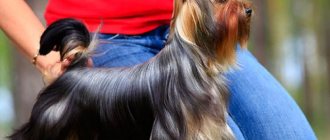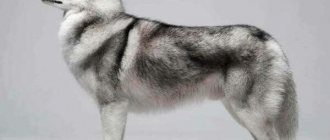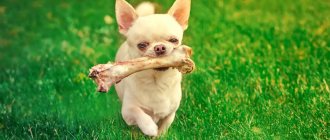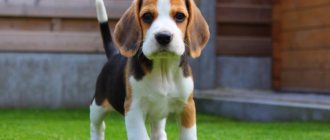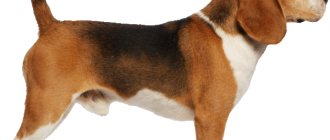When thinking about companion dogs, we will definitely mention Labradors. These are loyal and friendly four-legged friends who really suffer from loneliness. Obedient and smart pets, well trained, loving training. Patient, flexible and tireless service dogs.
Representatives of the breed grow, on average, up to 1 year. During this period, the owner must keep a diary of the development of his puppy - he writes down how much the pet has grown and how much weight it has gained. This is very important for Labradors - dogs are prone to obesity. It not only deprives you of the joys of a full life, but also leads to serious problems with the heart and blood vessels.
Description of the breed
Today, the Labrador dog is one of the most popular breeds around the world, and the number of its admirers is constantly growing. The pet is considered an impeccable family dog, combining the best qualities: sociability, devotion to the owner, calmness, friendliness. It is generally believed that Labradors were first bred on the Canadian islands. However, there is still much controversy surrounding the origin of the breed.
Some believe that at first Labradors were exclusively black, and were named after labradorite, a mysterious dark stone. The opposite opinion says that the breed originated on the Labrador Peninsula of the same name.
Due to their sharp mind, intelligence and balance, Labradors are often used as service dogs. The training of these dogs is not based on anger and grueling exercises, but solely on loyalty to people.
There have been cases when pets came to the aid of epileptics, since animals have the ability to anticipate seizures. In case of danger, the dogs try to warn the owner about the threat and give a sign for him to find a protected corner for himself.
What a Labrador looks like is known to both experienced and novice dog breeders. This is a large, muscular dog with a solid build. He has a flat skull, a deep chest and a strong back. The main characteristics of the breed include a clear transition from the forehead to the muzzle, medium-sized eyes and drooping ears. Labradors come in 3 colors: black, fawn and brown.
Labrador is a dream dog, attracting with its boundlessly devoted eyes
The feeding pattern for all puppies is the same: a 3-month-old Labrador should be fed 6 times a day, a puppy under 5 months should be fed 5 times, and 7-month-old Labradors should be fed a maximum of 4 times a day. After 9-10 months, dogs switch to 3 feedings a day, and after a year, the Labrador is fed 2 times at a clearly established time.
About natural food
If you decide to feed your dog food of natural origin, then you should learn a few simple rules:
- Dogs of this breed are highly prone to allergic reactions, so introduce all new foods into the animal’s diet gradually and in small quantities.
- Many Labrador puppies cannot tolerate buckwheat. But all protein products - meat, fish, cottage cheese, kefir, as a rule, are absorbed well. They gradually become familiar food for the family pet. Instead of buckwheat, the animal is fed wheat, corn, and barley groats.
- Vegetables and fruits are well tolerated by animals, especially since they are a source of complete vitamins and microelements. The animal can be given boiled cabbage, peppers, tomatoes. As for fruits, many Labradors eat apples, pears, persimmons, and watermelons well. But remember the risk of allergies; the first time you feed a new product, make do with a small piece.
- After 3 months of age, the baby can be given soft cartilage and beef bones.
Beef bones for dogs
Gallery: Labrador puppies (25 photos)
What should a pet be able to do?
First of all, the baby must understand his place in the pack. The first attempts to dominate should be firmly suppressed.
Also at this age, the baby must respond to a nickname, adhere to the feeding schedule, walk on a leash, be friendly to other four-legged animals, allow him to be groomed, maintain cleanliness, ask to go outside, and not react to sudden sounds.
By the beginning of the fifth month, he is obliged not to ignore, but to carry out all the learned commands , such as:
- Place!
- Ugh!
- It is forbidden!
- To me!
- Go for a walk!
IMPORTANT!
The puppy must know that the leader (owner) has the right to all things in the house.
Choosing a puppy
Selecting a purebred puppy is a difficult step that requires maximum responsibility. First of all, you need to determine the purpose for which you want to purchase a pet: do you dream of prizes and awards, or simply need mutual love.
Of course, dogs for participation in exhibitions cost more than ordinary pets. It is also necessary to understand that the guarantor of triumph in bets is neither the cost of the dog nor the owner’s offer, however, responsibility for the pet lies entirely with you, regardless of whether the dog wins prizes or not.
The best period when puppies can already be separated from their mother is considered to be 4-8 weeks. When choosing a Labrador, you need to pay attention to where it is kept. If the dog is in good conditions and surrounded by space and comfort, this indicates the care and love of the owner for his pet.
Nothing terrible happens
When talking about mating, it is definitely worth explaining such a physiological phenomenon as a “lock”. Dogs enter this state in the final stage. Outwardly, everything looks quite strange. They stand with their backs pressed against each other. For ignorant people, it may seem that something terrible has happened - the poor animals cannot disentangle themselves and are stuck to each other. In fact, everything is understandable.
The fact is that during intercourse, the bulb of the genital organ (head) of a male dog increases significantly in size. At the same time, it is tightly clamped by the muscles of the bitch’s vagina. This is how a “lock” or state of gluing is obtained. The male can free himself only after the head reaches its normal size and the vaginal muscles relax. This takes 10-15 minutes, and sometimes more. This is how nature took care of creating conditions for fertilization during mating.
At this time, the dogs should not be disturbed; they should be given the opportunity to complete the process.
By the way, mating is also observed in other dog-like animals - wolves, hyenas, jackals.
Features of care
The dog has absorbed many talents and abilities. She is not only a reliable guard for her owner, but also a loyal friend and a hardworking assistant. Those who decide to purchase a Labrador must take into account that caring for and raising an animal requires considerable effort. This rather temperamental dog needs long walks, training and outings. If the owner fails to provide the dog with such conditions, it will find entertainment for itself, which, most likely, the owner will not like.
Caring for a Labrador's coat is a simple process; you just need to brush the dog once a week with a special rubber brush. If your pet is accustomed to this procedure in time, he will even be able to love it. Brushing is beneficial for a dog as it increases blood circulation, removes fallen hair and stimulates the growth of new hair. Among other things, it is advisable to periodically examine the dog’s ears, eyes, teeth and claws for infections or other diseases, and if signs of any illness are detected, you should immediately seek help from a veterinarian.
Pet health
Animals are quite fragile, so you need to contact a veterinarian with the slightest problem. Only a qualified veterinarian will help the dog. Representatives of this breed are prone to acute respiratory viral infections, allergies, and obesity. Dogs are regularly vaccinated according to the vaccination calendar.
The troubles of caring for a four-legged friend are more than compensated by having a faithful, kind and affectionate companion nearby. Moreover, the flexible nature of the Labrador allows him to get along well with the older generation and children.
Labrador training
The Labrador is a sincere dog whose character depends entirely on its emotional connection with its owner and other people close to it. The more time and love he gets from his owner, the more trusting and devoted a pet is.
The introduction of a Labrador puppy into the home should be carefully thought out. First of all, you need to remove all dangerous objects from general availability, arm yourself with healthy nutritious food and toys. The pet must also be given a personal place to rest.
Commands such as “Down!” and “Near!”, you should start training your Labrador puppy at 1 month. The dog gets used to his name quickly enough and within a few days begins to understand that his name is his. You should not yell at a dog if it does not come on command, even if there are good reasons for this.
Labrador puppies should be accustomed to intensive training at 3 months. During this period, they are already more intelligent and resourceful. However, each dog shows individual capabilities and training abilities. Some Labradors master the necessary commands in two to four weeks, while others achieve the same results within several months. It is important not to overload the dog and give him time to rest from constant training.
How much does an adult dog weigh?
Labrador is a large breed of dog. The sizes depend on the sex of the individual; girls look slightly smaller than boys. Optimal performance for an adult dog:
- height – 0.56-0.63 m (for a male) and 0.54-0.6 (for a female);
- weight – 27-40 kg (for a male) and 27-35 kg (for a female).
During canine shows, experts take measurements of dogs and compare them with standard indicators. The breed has 3 recognized standards: international, English and American. British and world standards are almost identical. They allow deviations from growth parameters of up to 1 cm. The American template is more flexible. According to it, the height of the animal at the withers may differ by 3-5 cm.
Body weight is not so strictly regulated. However, the general proportions (the ratio of height at the withers and weight) must be maintained. As a rule, an adult Labrador weighs around 30 kg. Excess weight affects your pet's health. Owners must properly balance the daily diet of the ward, and also pay attention to physical activity during walks.
How much does your Labrador weigh?




